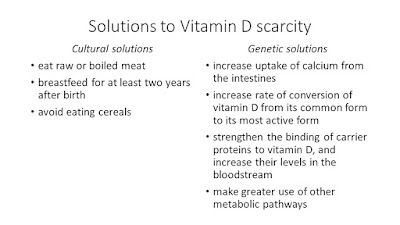Vitamin
D metabolism varies from one human population to another, as do most heritable
traits. This is the subject of a review article I’ve recently published in the
journal Nutrients. Here is the
abstract:
Vitamin
D metabolism differs among human populations because our species has adapted to
different natural and cultural environments. Two environments are particularly
difficult for the production of vitamin D by the skin: the Arctic, where the
skin receives little solar UVB over the year; and the Tropics, where the skin
is highly melanized and blocks UVB. In both cases, natural selection has
favored the survival of those individuals who use vitamin D more efficiently or
have some kind of workaround that ensures sufficient uptake of calcium and
other essential minerals from food passing through the intestines. Vitamin D
scarcity has either cultural or genetic solutions. Cultural solutions include
consumption of meat in a raw or boiled state and extended breastfeeding of
children. Genetic solutions include higher uptake of calcium from the
intestines, higher rate of conversion of vitamin D to its most active form,
stronger binding of vitamin D to carrier proteins in the bloodstream, and
greater use of alternative metabolic pathways for calcium uptake. Because their
bodies use vitamin D more sparingly, indigenous Arctic and Tropical peoples can
be misdiagnosed with vitamin D deficiency and wrongly prescribed dietary
supplements that may push their vitamin D level over the threshold of toxicity.
Reference
Frost
P. (2022) The Problem of Vitamin D Scarcity: Cultural and Genetic Solutions by
Indigenous Arctic and Tropical Peoples. Nutrients 14(19):4071. https://doi.org/10.3390/nu14194071

No comments:
Post a Comment